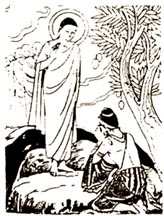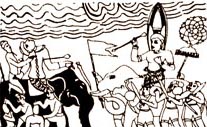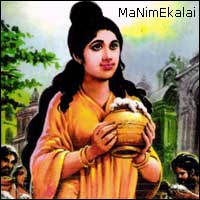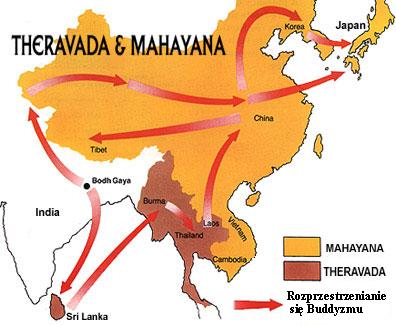Ilankai Tamil Sangam29th Year on the Web Association of Tamils of Sri Lanka in the USA |
||||||
 Home Home Archives Archives |
Why is Sri Lanka's Past Hidden from its Own People?by Ameen Izzadeen, Khaleej Times, July 3, 2007
SRI Lanka’s Hindu king Devanampiyatissa (246 BCE), who ruled from Anuradhapura in the north-central province of Sri Lanka was on a hunting mission and chasing after a spotted deer. And suddenly, he heard a voice: Someone calling him by his first name. No one in his kingdom would dare to utter his name. Shocked, he stopped his chase and turned towards the direction from where the voice was heard.
There was Mahinda Thera, son of Emperor Asoka. He urged the king not to kill. With this advice began the spread of Buddhism in Sri Lanka. On Saturday, June 30, Sri Lankan Buddhists marked this event with religious ceremonies throughout the country. But there was not much celebration in the north and the east. It was not because of the war. But there aren’t many Buddhists in these areas, especially in the north. The north is pre-dominantly Tamil Hindu. Many people in the north see Buddhism as the religion of the ‘Sinhala’ Army, which they respect least but fear most. The Buddhism, which Mahinda Thera preached, spoke of non-violence and social egalitarianism. The appeal of this reformist religion was so overwhelming that it spread like wildfire. For centuries, it was the main religion of Tamils in India’s Tamil Nadu and in Sri Lanka. It was unfortunate that very little attempt is made by authorities to highlight this historic fact. On the contrary, text books recommended for children in their tender ages contain stories that plant seeds of ethnic hatred in their hearts. In one lesson, the young Sinhala prince Dutugemunu was asked by his mother why he was huddling under a blanket. The prince replied in a typical devil-and-the–deep-blue-sea manner, “How can I straighten my limbs, when on the one hand, we are surrounded by the dumb sea and on the other, by the ‘para’ Tamils”. The decent transliteration of the word ‘para’ means ‘foreign’. But the word is also being used to denote something derogatory or low. I am not an etymologist, but I believe the word in its derogatory sense refers to the ‘Pariah’ caste of south India. Ironically, many people belonging to this caste later converted to Buddhism.
When I asked about this lesson, a teacher of a Methodist church-run school was apologetic and told me, “We skip it.” Dutugemunu was not a racist. Neither was the Chola king Elara, a Tamil, whom he defeated and killed in battle. If only we have presented history in the right context, Sri Lanka would have been a peaceful country. It is still not too late. For a start, let’s teach our children that there were Tamil Buddhists in this country. Some ultranationalists are quick to grab artifacts found in the north and say that the discoveries were proof enough to show that Buddhism was once prevalent in every part of the country. Their conclusion, however, was that there were Sinhalese in the north, practising Buddhism. They failed to acknowledge that Tamils in the north were once Buddhists. A reading of the great Tamil epic, Manimekalai, by the 2nd century Tamilnadu poet, Sathanar, would expose one to the influence of Buddhism among Tamils in Tamil Nadu and northern Sri Lanka. Not many Sri Lankan Buddhists today know who Manimekala is. Neither do they know that Tamil Nadu Dalits who have embraced Buddhism – and continue to embrace it — are hurt when they learn that the Sinhalese, most of whom profess Buddhism, are portrayed as the oppressors of Tamils in Sri Lanka. The universality of the philosophy preached by Gautama Buddha has unfortunately been replaced by communality. There is little effort to take Buddhism to Tamils in the north and east. With some Buddhist monks themselves backing the government’s war effort, what success the efforts to promote the Buddha’s philosophy of non-violence will meet is anybody’s guess. The message with which the Mahinda Thera wooed the king to ‘ahimsa’ is lost in the jungles of bigotry. The Buddha’s teachings tell us to abhor greed, but our politicians, in their greed for power, refuse to devolve power to the Tamils in a meaningful way. Buddhism also emphasises the virtues of detachment because it identifies attachment as the main factor that leads to sorrow. But our attachment to concepts such as race, language and ethnicity has become a barrier to a peaceful solution to the Sri Lankan crisis. Ameen Izzadeen is a Sri Lankan journalist based in Colombo |
|||||
|
||||||


 Manimekala was about to marry a prince, who was infatuated with her. But the death of her father, Kovalan, hero of another Tamil epic, Silappathikaram, made her contemplate on the impermanency of life. Caught between the love of a prince and her passion to become a nun, Manimekala was in a state of confusion. She was rescued by a goddess and taken to Nagadipa, an island off Jaffna. It was here that she walked into a site hallowed by the visit of the Buddha. The legend has it that Buddha visited Nagadipa to settle a dispute between two princes over a gem-set throne. Manimekala was exposed to the teachings of the Buddha. She was handed a sacred bowl which Buddhist monks and nuns carry. She departed Nagadipa and reached Kaveripatnam, Madurai where she donned the robe of a Buddhist nun, and began her spiritual mission. With the begging bowl in her hand, she served the poor and the marginalised.
Manimekala was about to marry a prince, who was infatuated with her. But the death of her father, Kovalan, hero of another Tamil epic, Silappathikaram, made her contemplate on the impermanency of life. Caught between the love of a prince and her passion to become a nun, Manimekala was in a state of confusion. She was rescued by a goddess and taken to Nagadipa, an island off Jaffna. It was here that she walked into a site hallowed by the visit of the Buddha. The legend has it that Buddha visited Nagadipa to settle a dispute between two princes over a gem-set throne. Manimekala was exposed to the teachings of the Buddha. She was handed a sacred bowl which Buddhist monks and nuns carry. She departed Nagadipa and reached Kaveripatnam, Madurai where she donned the robe of a Buddhist nun, and began her spiritual mission. With the begging bowl in her hand, she served the poor and the marginalised.